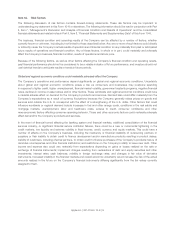Apple 2014 Annual Report Download - page 20
Download and view the complete annual report
Please find page 20 of the 2014 Apple annual report below. You can navigate through the pages in the report by either clicking on the pages listed below, or by using the keyword search tool below to find specific information within the annual report.The Company expects its quarterly revenue and operating results to fluctuate.
The Company’s profit margins vary across its products and distribution channels. The Company’s software, accessories, and
service and support contracts generally have higher gross margins than certain of the Company’s other products. Gross
margins on the Company’s hardware products vary across product lines and can change over time as a result of product
transitions, pricing and configuration changes, and component, warranty, and other cost fluctuations. The Company’s direct
sales generally have higher associated gross margins than its indirect sales through its channel partners. In addition, the
Company’s gross margin and operating margin percentages, as well as overall profitability, may be materially adversely
impacted as a result of a shift in product, geographic or channel mix, component cost increases, the strengthening U.S. dollar,
price competition, or the introduction of new products, including those that have higher cost structures with flat or reduced
pricing.
The Company has typically experienced higher net sales in its first quarter compared to other quarters due in part to seasonal
holiday demand. Additionally, new product introductions can significantly impact net sales, product costs and operating
expenses. The Company could be subject to unexpected developments late in a quarter, such as lower-than-anticipated
demand for the Company’s products, issues with new product introductions, an internal systems failure, or failure of one of the
Company’s logistics, components supply, or manufacturing partners.
The Company’s stock price is subject to volatility.
The Company’s stock price has experienced substantial price volatility in the past and may continue to do so in the future.
Additionally, the Company, the technology industry and the stock market as a whole have experienced extreme stock price
and volume fluctuations that have affected stock prices in ways that may have been unrelated to these companies’ operating
performance. Price volatility over a given period may cause the average price at which the Company repurchases its own stock
to exceed the stock’s price at a given point in time. The Company believes its stock price reflects expectations of future growth
and profitability. The Company also believes its stock price reflects expectations that its cash dividend will continue at current
levels or grow and that its current share repurchase program will be fully consummated. Future dividends are subject to
declaration by the Company’s Board of Directors, and the Company’s share repurchase program does not obligate it to
acquire any specific number of shares. If the Company fails to meet any of these expectations related to future growth,
profitability, dividends, share repurchases or other market expectations, its stock price may decline significantly, which could
have a material adverse impact on investor confidence and employee retention.
The Company’s financial performance is subject to risks associated with changes in the value of the U.S. dollar versus
local currencies.
The Company’s primary exposure to movements in foreign currency exchange rates relates to non-U.S. dollar denominated
sales and operating expenses worldwide. Weakening of foreign currencies relative to the U.S. dollar adversely affects the U.S.
dollar value of the Company’s foreign currency-denominated sales and earnings, and generally leads the Company to raise
international pricing, potentially reducing demand for the Company’s products. Margins on sales of the Company’s products in
foreign countries and on sales of products that include components obtained from foreign suppliers, could be materially
adversely affected by foreign currency exchange rate fluctuations. In some circumstances, for competitive or other reasons, the
Company may decide not to raise local prices to fully offset the dollar’s strengthening, or at all, which would adversely affect the
U.S. dollar value of the Company’s foreign currency denominated sales and earnings. Conversely, a strengthening of foreign
currencies relative to the U.S. dollar, while generally beneficial to the Company’s foreign currency-denominated sales and
earnings, could cause the Company to reduce international pricing and incur losses on its foreign currency derivative
instruments, thereby limiting the benefit. Additionally, strengthening of foreign currencies may also increase the Company’s
cost of product components denominated in those currencies, thus adversely affecting gross margins.
The Company uses derivative instruments, such as foreign currency forward and option contracts, to hedge certain exposures
to fluctuations in foreign currency exchange rates. The use of such hedging activities may not offset any, or more than a
portion, of the adverse financial effects of unfavorable movements in foreign exchange rates over the limited time the hedges
are in place.
Apple Inc. | 2014 Form 10-K | 18
























